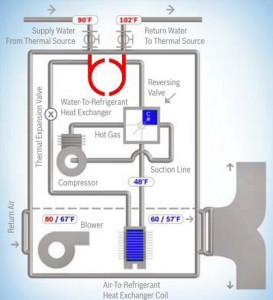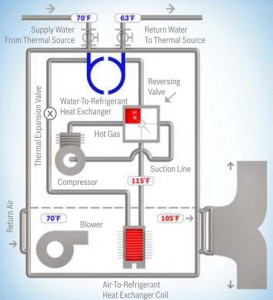So you know that one of the benefits of geothermal is that part of the heat exchange process happens in the earth, not in the open air like a conventional heat pump system. But to make that happen, what else has to occur? What “extra” parts are needed? Interesting questions, but the differences are not actually that prominent.Conventional HVAC Systems
In a conventional heat pump split system there is an indoor unit and an outdoor unit. Refrigeration lines connect the two, and refrigerant has to travel that entire path, all the time losing a bit of efficiency. The refrigeration lines are insulated of course, so not much heat loss occurs, but it does happen.
Components are divided between the indoor unit and the outdoor unit. The expansion device, reversing valve, and evaporator are in the indoor unit. Refrigeration suction and liquid lines run from the indoor unit to the outdoor unit. The compressor and condenser are both located in the outdoor unit. There are heat transfer coils and fans in both units to create the heat exchanges.
Geothermal Heat Pump Components
For the most part the components of a geothermal heat pump are the same as a conventional air source heat pump split system. The biggest difference is that the geothermal loop takes place of the outdoor heat exchanger. Put simpler, there is no outdoor unit, because that is what is in the earth.
To make that happen, the indoor unit becomes more important. All the refrigeration piping, circuiting, and equipment are now housed in the geothermal heat pump (indoor unit). The compressor moves to the heat pump. The long refrigeration lines are eliminated, as the entire circuit is housed in the heat pump. The outdoor heat exchanger coil becomes a water cooled coil. Basically this means that geothermal loop water flows across the condenser to exchange heat with it. To make this happen, a small water pump is used instead of the traditional condenser fan.
Differences for Heating and Cooling
Heat pumps can operate in cooling mode and heating mode. The components used for both are the same, with one slight difference. The difference isn’t the addition of a component, but rather the configuration of it.
The reversing valve is an extremely important component of any heat pump. It controls the direction of refrigerant flow inside the heat pump. As hot vapor leaves the compressor, it approaches the reversing valve. When the heat pump is in heating mode, the hot vapor is directed to the coil in the indoor airstream. Note the refrigerant flow in the diagram. In this situation the heat pump draws heat from the geothermal water and heats the home. Geothermal water is made cooler, and is pumped through the loop to gather heat.In cooling mode, the hot vapor from the compressor is directed to the water cooled condenser coil. Here the vapor puts heat into the geothermal water, which is sent to sink the water in the ground. The other components of the cycle retain their function. In both situations the return air is blown across the heat exchanger to make the air warmer or cooler.
Pros and Cons of Geothermal Heat Pump Component Configuration
Now that we’ve covered the differences between the components in a conventional system, we’ll discuss the pros and cons of the geothermal configuration vs the conventional configuration.
Pros:
- Less refrigeration piping, less refrigerant.
- Higher efficiency
- Maintenance can be done in one location.
- No worries about refrigeration line arrangement, which can be difficult.
Cons:
- Indoor unit is louder because compressor is inside.
- Geothermal water piping to outdoor trench is more difficult than drilling refrigerant piping holes.
- More expensive up front cost.
Over the lifetime of the unit, it is certainly cheaper to have the geothermal unit configuration. There are a few aspects that make it more difficult, but the pros very much outweigh the cons. Even the biggest drawback, noise, is a source of constant engineering innovation. Compressor technology has even outpaced geothermal adoption because they know this is often a limiting factor in people’s decisions. Two stage and variable speed compressors are now readily available, providing quieter and ultra efficient options.

